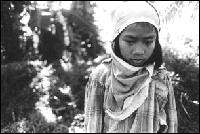|
|
| Director: Ditsi Carolino, Sadhana Buxani Script: Ditsi Carolino Photography: Ditsi Carolino, Sadhana Buxani Editing: Ditsi Carolino,Bobby Regalado Music: Ronnie Quesada Sound: Sadhana Buxani Producer: Ditsi Carolino, Ateneo Center for Social Policy, Archdiocese of Manila Labor Centre Source: Ditsi Carolino, Sadhana Buxani Sunrise Cottage, P5 Area 14, Velasquez St. U.P.Campus Diliman, Q.C. PHILIPPINES Phone & Fax: 63-2-928-80-29, e-mail: earthsta@gaia.psdn.iphil.net PHILIPPINES / 1996 / English, Filipino / B&W / Video / 50 min |
Ditsi Carolino got a degree in Sociology at the University of the Philippines. She began her career doing photography and slideshows for grassroots communities for five years. Since attending a film workshop in 1991, she has directed documentaries, many of them on the lives and struggles of the poor. Films include: Masakit sa Mata (co-dir, 91), Manggagawa, Kamanlilikha (91), Trails to an Answer (92), Dapit-hapon sa Tambakan (93), Pinakatagong Lihim ng Simbahan (94), Liberating Coops (94), Keeping the Coop Fire Burning (95), No Time for Play (96). Her documentaries, notably the ones on children, have won awards in the Philippines.
Sadhana Buxani is a visual artist and documentary photographer. She also worked as a community organizer in war-torn Mindanao and the slums of Manila before she began to make documentaries. Children Only Once is her debut film. |
 |
|
| This is a documentary about child labor in the Philippine provinces. The directors recorded small children working under excruciating conditions in slaughterhouses, sugarcane fields, and ship docks in order to add to their family income. Images of the children's carefree joy after release from work capture the essence of childhood and emphasize their plight. | |
|
|
|
|
Director's Statement It's funny how one film can take you in directions you never imagined. When we began this project, all we wanted was to do an eye-opener on child labor. One that would remove the blinders from viewers so used to seeing child labor as part of the landscape of a developing country. We started off trying to produce something to convince others. In the end, we came off the biggest converts. You can't film these children's lives without looking deep into your own and the line of responsibility that links us all. In the end, we found ourselves becoming more than just documentarists; we had turned advocates.We became part of a network of NGOs working against child labor. The kids we interviewed were articulate, child-like yet mature for their age. The hard life they led built extraordinary characters which translated so well in the documentary form. We marveled at how openly they shared their lives and thoughts with us. Of course it helped that we were a small crew with very simple equipment. We operated as a two-woman team doing research, camera, sound, script, and PA work altogether. No heavy equipment, no lights, no big guys to intimidate them... This helped the children to open up. And by simply being themselves, the children generate a tremendous amount of empathy from viewers who are invariably moved by their strength and stoicism, resilience and humor. |
|

